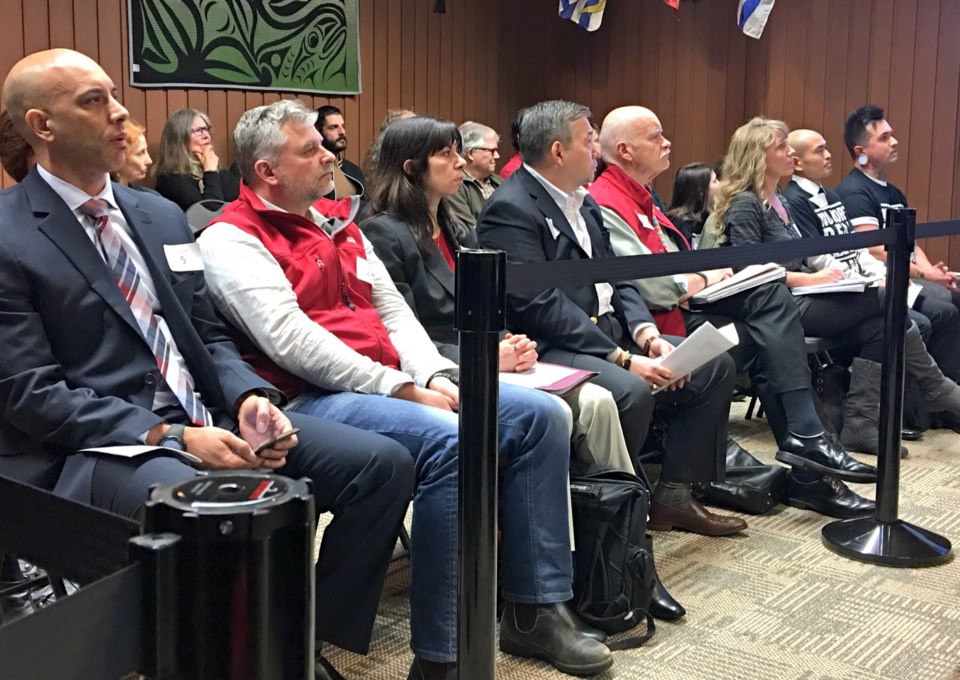In case there was any doubt as to the weight of the decision facing the park board, one of nearly two dozen people who spoke passionately about whales and dolphins at the Vancouver aquarium asked of the commissioners: “Future generations, will they be proud or ashamed of your legacy?”
Out of 64 people who signed up to speak, on March 8 the park board heard from 26 of them, including a 90-minute presentation followed by rounds of questioning with the aquarium CEO, chief veterinarian and chairman.
“Like you, our board has struggled with this situation as well,” said Derral Moriyama, chairman of the aquarium board of directors. “We all want to do what we think is the right thing for nature, for the community.”
The meeting will continue tonight, March 9, beginning at 6 p.m. at the park board office.
In wading through the passion and expertise of speakers, which included two children wearing “no more dead cetacean” t-shirts, the argument came down to the scientific value of keeping belugas and other cetaceans in captivity for the sake of research and greater understanding about the changing climate, environmental stressors on declining wild populations, and environmental conservation efforts to mitigate both. If keeping the large mammals in a concrete tank is not justified for scientific reasons, the park board is also contending with whether cetaceans, such as calves or injured animals, should still be brought to the aquarium for rescue and rehabilitation if there is little to no chance they will be released back to the wild.
“There is so much work that has to be done on animals in care that just can’t be done in the wild,” said Marty Haulena, the aquarium’s chief veterinarian. “It’s the tools that we develop in places like ours… all of the more facilities that have animals like beluga, the more chance beluga have out there. We have just got to know more.”
He said a historic population of 10,000 to 12,000 beluga in the St. Lawrence Estuary is now as low as 800. For example, studying the effect of marine traffic noise pollution on the increased risk of separating calves from mothers can help safeguard against further decline, he said, because it can influence maritime regulation.
John Nightingale, the president and CEO of the aquarium, said the planned multi-million dollar expansion project could be designed to convert its tanks for smaller animals once or if belugas never return. The biologist said, because of the age of the current tanks, the “steel soaked in seawater needs to be replaced.”
He said initial plans saw the new facility opening in 2019, but with uncertainty around changing park board values and bylaws, the project has stalled and been reduced from its original size. If allowed to keep cetaceans, the aquarium will phase out their captivity by 2029, he said.
1.2 million people visited the aquarium last year and, after orca whales were phased out nearly two decades ago, attendance dropped before recovering. General admission to the aquarium is $36 for an adult and $21 for children aged four to 12.
Numerous scientists who addressed commissioners said study of the captive animals can help understand wild populations since, “in science, every answer gets you two more questions,” said the CEO.
The park board heard from numerous academics, who agreed with that assessment, including a cognitive psychologist using sea pens as part of her work on cetaceans at the Dolphin Research Center in Florida, and a zoologist at UBC’s Marine Mammal Research Unit who specializes in sea lion research.
The five belugas that are currently at other marine parks in North America would not survive in the wild, aquarium staff said.
On the other side of the debate, the park board heard from a dozen speakers opposed to whales and cetaceans held in captivity at the aquarium for display, breeding or research purposes. The goal of rescue and release was endorsed by many speakers.
David Isbister with the organization No More Dead Cetaceans said, according to aquarium financial records, only 15 per cent of their budget is spent on rescue. He told a story about being inspired by the aquarium, as many children are through education and awareness about the world’s oceans, when a planned visit to see orca whales was cancelled because a calf died in it tank. The experience opened his eyes to many unanswered questions, he said.
“The institution would survive with or without beluga captivity,” he added, noting the research has scientific value but does not justify keeping large, free-ranging animals in land-locked tanks. “One dead cetacean every 1.4 years does not excuse the sporadic rescue of seals,” he said.
Two former sailors who had said they travelled with the Sea Shepherd Conservation Society described rescuing animals from nets and fishing lines as well as deterring poaching around the world.
Both Nightingale and Haulena tried to discredit these opponents.
“This is a small group of incredibly vocal people,” said the vet, “that have an agenda and it’s not about research, it’s not about animal welfare, it’s not about education – that is what we are about. They are about something else alltogether.”
All seven commissioners asked multiple questions of the speakers, from belugas being sentient beings that grieve for their dead relations, to the possible use of sea pens in animal care and rehabilitation.
Speakers will continue to address the board tonight before the commissioners debate amongst themselves. They will likely make a decision on the fate of the aquarium but could also defer until a later date.
The park board has four options to consider. It can maintain the status quo and change nothing or it can rewrite bylaws to limit cetaceans in captivity but for reasons like rehabilitation and release. It can endorse the aquarium’s multi-million dollar expansion plans and intent to bring three to five belugas to an enlarged Arctic exhibit. Or, it can decide to hold a plebiscite in 2018, but only with the endorsement of city hall.



